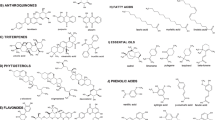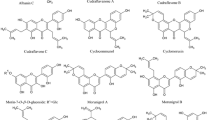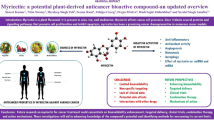Abstract
The discovery of novel antitumor agents derived from natural plants is a principal objective of anticancer drug research. Frankincense, a widely recognized natural antitumor medicine, has undergone a systematic review encompassing its species, chemical constituents, and diverse pharmacological activities and mechanisms. The different species of frankincense include Boswellia serrata, Somali frankincense, Boswellia frereana, and Boswellia arabica. Various frankincense extracts and compounds exhibit antitumor, anti-inflammatory, and hepatoprotective properties and antioxidation, memory enhancement, and immunological regulation capabilities. They also have comprehensive effects on regulating flora. Frankincense and its principal chemical constituents have demonstrated promising chemoprophylactic and therapeutic abilities against tumors. This review provides a systematic summary of the mechanism of action underlying the antitumor effects of frankincense and its major constituents, thus laying the foundations for developing effective tumor-combating _targets.
Similar content being viewed by others
Abbreviations
- AKBA:
-
ethanophthalyl-11-keto-β-mastic acid
- APC:
-
adenomatous polyposis coli
- NF-κB:
-
nuclear factor- κB
- Cox-2:
-
cyclooxygenase-2
- NSCLC:
-
non-small cell lung cancer
- CRC:
-
colorectal cancer
- DNMT:
-
DNA methyltransferase
- Bcl-2:
-
B-cell lymphoma-2
- Bcl-xL:
-
B-cell lymphoma-extra large
- IAP-1:
-
Inhibitor of apoptosis protein-1
- ICAM-1:
-
intercellular adhesion molecule 1
- MMP-9:
-
matrix metalloproteinase-9
- CXCR4:
-
C-X-C motif chemokine receptor 4
- VEGF:
-
vascular endothelial growth factor
- miR-200:
-
microRNA-200
- PI3K:
-
phosphatidylinositol-3-kinase
- Akt:
-
protein kinase B
- HCC:
-
hepatocellular carcinoma
- PCa:
-
prostate cancer
- Stat3:
-
signal transducer and activator of transcription 3
- DR5:
-
death receptor 5
- AR:
-
androgen receptor
- VEGFR2:
-
vascular endothelial growth factor receptor 2
- LC3B:
-
light chain 3B
- GBM:
-
glioblastoma
- ATG5:
-
recombinant autophagy-related protein 5
- p62:
-
prostacyclin62
- ERK:
-
extracellular regulated protein kinases
- P53:
-
tumor protein p53
- BB:
-
platelet-derived growth factor-BB
- PAAD:
-
pancreatic adenocarcinoma
- EAC:
-
ehrlich ascites carcinoma
- DR4:
-
cell death receptor 4
- TNF-R1:
-
tumor necrosis factor-R1
- CSLCs:
-
cancer stem-like cells
- BO:
-
boswellia ovalis
- TNBC:
-
triple-negative breast cancer
- MDA-MB-231:
-
metastatic triple-negative breast cancer cells
- ac-LA:
-
acetyl-lupeolic acid
- PTA:
-
pentacyclic triterpenic acid
- CXCA:
-
cervix cancer
- PDK1:
-
pyruvate dehydrogenase kinase 1 Gene
- β-EA:
-
β-elemonic acid
- HOS:
-
human osteosarcoma cells
- AMPK:
-
adenosine 5′-monophosphate (AMP)-activated protein kinas
- FEE:
-
frankincense ethanol extract
- TNF-α:
-
tumor necrosis factor-alpha
- IL-6:
-
interleukin 6
- BS:
-
Boswellia serrata
- GSK3β:
-
glycogen synthase kinase 3β
- BFE:
-
Boswellia frereana extract
- c-Met:
-
cellular-mesenchymal epithelial transition factor
- HGF:
-
hepatocyte growth factor
- FEO:
-
lactobacillus essential oil
- CDK4:
-
cyclin-dependent kinase 4
- Bax:
-
BCL2-Associated X
- MCL-1:
-
myeloid cell leukemia-1
- mPGES-29:
-
microsomal prostaglandin E synthase-1
- PGE1:
-
prostaglandin E1
- PC-3:
-
prostate cancer cell line
- CIPN:
-
chemotherapy-induced peripheral neuropathy
- Ref:
-
reference
References
Hamidpour R, Hamidpour S, Hamidpour M, et al. Frankincense (r ǔ xi ā ng; Boswellia species): from the selection of traditional applications to the novel phytotherapy for the prevention and treatment of serious diseases. J Tradit Complement Med 2013;3:221–226.
Afsharypuor S, Rahmany M. Essential oil constituents of two African Olibanums available in Isfahan commercial market. Iran J Pharmacol Sci 2005;1:167–170.
Decarlo A, ed. Sustainable frankincense production system in Somali-land—a management guide. Hargeisa, Somaliland: Conserve the CalMadow; 2017:3.
Frank MB, Yang Q, Osban J, et al. Frankincense oil derived from Boswellia carteri induces tumor cell specific cytotoxicity. BMC Complement Altern Med 2009;9:6.
Rumgay H, Arnold M, Ferlay J, et al. Global burden of primary liver cancer in 2020 and predictions to 2040. J Hepatol 2022;77:1598–1606.
Dai G, He L, Yan Q, et al. Case report: advanced pulmonary sarcomatoid carcinoma with adrenal gland metastasis after sintilimab combined with anlotinib treatment. Front Oncol 2023;13:1167516.
Motyka S, Jafernik K, Ekiert H, et al. Podophyllotoxin and its derivatives: potential anticancer agents of natural origin in cancer chemotherapy. Biomed Pharmacother 2023;158:114145.
Kaur H, Kaur K, Singh A, et al. Frankincense oil-loaded nanoemulsion formulation of paclitaxel and erucin: a synergistic combination for ameliorating drug resistance in breast cancer: in vitro and in vivo study. Front Pharmacol 2022;13:1020602–1020602.
Li W, Liu J, Fu W, et al. 3-O-acetyl-11-keto-β-boswellic acid exerts anti-tumor effects in glioblastoma by arresting cell cycle at G2/M phase. J Exp Clin Cancer Res 2018;37:132. Erratum in: J Exp Clin Cancer Res 2022;41:236.
Gong Y, Jiang X, Yang S, et al. The biological activity of 3-O-acetyl-11-keto-β-boswellic acid in nervous system diseases. Neuromolecular Med 2022;24:374–384.
Siemoneit U, Koeberle A, Rossi A, et al. Inhibition of microsomal prostaglandin E2 synthase-1 as a molecular basis for the anti-inflammatory actions of boswellic acids from frankincense. Br J Pharmacol 2011;162:147–62.
Stürner KH, Verse N, Yousef S, et al. Boswellic acids reduce Th17 differentiation via blockade of IL-1 β-mediated IRAK1 signaling. Eur J Immunol 2014;44:1200–1212.
Park B, Sung B, Yadav VR, et al. Acetyl-11-keto-β-boswellic acid suppresses invasion of pancreatic cancer cells through the downregulation of CXCR4 chemokine receptor expression. Int J Cancer 2011;129:23–33.
Majeed M, Majeed S, Narayanan NK, et al. A pilot, randomized, double-blind, placebo-controlled trial to assess the safety and efficacy of a novel Boswellia serrata extract in the management of osteoarthritis of the knee. Phytother Res 2019;33:1457–1468.
Goswami D, Mahapatra AD, Banerjee S, et al. Boswellia serrata oleo-gum-resin and β-boswellic acid inhibits HSV-1 infection in vitro through modulation of NF-κB and p38 MAP kinase signaling. Phytomedicine 2018;51:94–103.
Ur Rehman N, Khan A, Al-Harrasi A, et al. New α-Glucosidase inhibitors from the resins of Boswellia species with structure-glucosidase activity and molecular docking studies. Bioorg Chem 2018;79:27–33.
Fathi E, Katouli FH, Riazi GH, et al. The effects of alpha boswellic acid on reelin expression and Tau phosphorylation in human astrocytes. Neuromolecular Med 2017;19:136–146.
Huang G, Yang J, Zhang L, et al. Inhibitory effect of 11-carbonyl-beta-boswellic acid on non-small cell lung cancer H446 cells. Biochem Biophys Res Commun 2018;503:2202–2205.
Yu J, Zhao L, Sun X, et al. Bioactive cembrane diterpenoids from the gum resin of Boswellia carterii. Fitoterapia 2020;146:104699.
Wang JJ, Sun HR, Suo XY, et al. Ten undescribed cembrane-type diterpenoids from the gum resin of Boswellia sacra and their biological activities. Phytochemistry 2020;177:112425.
Sun X, Geng Y, Wang X, et al. Cembrane-type diterpenoids from the gum resin of Boswellia carterii and their biological activities. RSC Adv 2020;10:746–755.
Zhang B, Liu D, Ji W, et al. Sacraoxides A-G, bioactive cembranoids from gum resin of Boswellia sacra. Front Chem 2021;9:649287.
Moussaieff A, Shohami E, Kashman Y, et al. Incensole acetate, a novel anti-inflammatory compound isolated from Boswellia resin, inhibits nuclear factor-kappa B activation. Mol Pharmacol 2007;72:1657–1664.
Pollastro F, Golin S, Chianese G, et al. Neuroactive and anti-inflammatory frankincense cembranes: a structure-activity study. J Nat Prod 2016;79:1762–1768.
Wang YG, Ren J, Wang AG, et al. Hepatoprotective prenylaromadendrane-type diterpenes from the gum resin of Boswellia carterii. J Nat Prod 2013;76:2074–2079.
Efferth T, Oesch F. Anti-inflammatory and anti-cancer activities of frankincense: _targets, treatments and toxicities. Semin Cancer Biol 2022;80:39–57.
Paulino BN, Silva GNS, Araujo FF, et al. Beyond natural aromas: the bioactive and technological potential of monoterpenes. Trends Food Sci Technol 2022;128:188–201.
Sanchez C, Zappia J, Lambert C, et al. Curcuma longa and Boswellia serrata extracts modulate different and complementary pathways on human chondrocytes in vitro: deciphering of a transcriptomic study. Front Pharmacol 2022;13:931914.
Hou J, Zhang Y, Zhu Y, et al. α-Pinene induces apoptotic cell death via caspase activation in human ovarian cancer cells. Med Sci Monit 2019;25:6631–6638.
An Q, Ren JN, Li X, et al. Recent updates on bioactive properties of linalool. Food Funct 2021;12:10370–10389.
Su S, Duan J, Chen T, et al. Frankincense and myrrh suppress inflammation via regulation of the metabolic profiling and the MAPK signaling pathway. Sci Reports 2015;5:1–15.
D’Amico R, Impellizzeri D, Cordaro M, et al. Regulation of apoptosis and oxidative stress by Oral Boswellia serrata gum resin extract in a rat model of endometriosis. Int J Mol Sci 2022;23:15348.
Quarta S, Santarpino G, Carluccio MA, et al. Analysis of the anti-inflammatory and anti-osteoarthritic potential of Flonat Fast®, a combination of Harpagophytum Procumbens DC. ex Meisn., Boswellia serrata Roxb., Curcuma longa L., Bromelain and Escin (Aesculus hippocastanum), evaluated in in vitro models of inflammation relevant to osteoarthritis. Pharmaceuticals 2022;15:1263.
Lv M, Zhuang X, Zhang Q, et al. Acetyl-11-keto-β-boswellic acid enhances the cisplatin sensitivity of non-small cell lung cancer cells through cell cycle arrest, apoptosis induction, and autophagy suppression via p21-dependent signaling pathway. Cell Biol Toxicol 2021;37:209–228.
Wang S, Wang H, Sun B, et al. Acetyl-11-keto-β-boswellic acid triggers premature senescence via induction of DNA damage accompanied by impairment of DNA repair genes in hepatocellular carcinoma cells in vitro and in vivo. Fundam Clin Pharmacol 2020;34:65–76.
Mahesh BU, Shrivastava S, Pragada RR, et al. Antioxidant and hepatoprotective effects of Boswellia ovalifoliolata bark extracts. Chin J Nat Med 2014;12:663–671.
Yu JQ, Zhao L, Zhang KW, Wang X. Anti-inflammatory and hepatoprotective cembranoid alcohols from the gum resin of Boswellia carterii. Fitoterapia 2021;155:105064.
Eltahir HM, Fawzy MA, Mohamed EM, et al. Antioxidant, anti-inflammatory and anti-fibrotic effects of Boswellia serrate gum resin in CCl4-induced hepatotoxicity. Exp Ther Med 2020;19:1313–1321.
Catanzaro D, Rancan S, Orso G, et al. Boswellia serrata preserves intestinal epithelial barrier from oxidative and inflammatory damage. PLoS One 2015;10:e0125375.
Khajehdehi M, Khalaj-Kondori M, Baradaran B. Molecular evidences on anti-inflammatory, anticancer, and memory-boosting effects of frankincense. Phytother Res 2022;36:1194–1215.
Ghaedi K, Dehestani H. Frankincense upregulates the hippocampal calcium/calmodulin kinase II-α during development of the rat brain and improves memory performance. Int J Dev Neurosci 2018;69:44–48.
Ammon HP. Modulation of the immune system by Boswellia serrata extracts and boswellic acids. Phytomedicine 2010;17:862–867.
Aldahlawi AM, Alzahrani AT, Elshal MF. Evaluation of immunomodulatory effects of Boswellia sacra essential oil on T-cells and dendritic cells. BMC Complement Med Ther 2020;20:352.
Liu HP, Gao ZH, Cui SX, et al. Chemoprevention of intestinal adenomatous polyposis by acetyl-11-keto-beta-boswellic acid in APC(Min/+) mice. Int J Cancer 2013;132:2667–2681.
Lv M, Zhuang X, Zhang Q, et al. Acetyl-11-keto-β-boswellic acid enhances the cisplatin sensitivity of non-small cell lung cancer cells through cell cycle arrest, apoptosis induction, and autophagy suppression via p21-dependent signaling pathway. Cell Biol Toxicol 2021;37:209–228.
Shen Y, Takahashi M, Byun HM, et al. Boswellic acid induces epigenetic alterations by modulating DNA methylation in colorectal cancer cells. Cancer Biol Ther 2012;13:542–552.
Yadav VR, Prasad S, Sung B, et al. Boswellic acid inhibits growth and metastasis of human colorectal cancer in orthotopic mouse model by downregulating inflammatory, proliferative, invasive and angiogenic biomarkers. Int J Cancer 2012;130:2176–2184.
Takahashi M, Sung B, Shen Y, et al. Boswellic acid exerts antitumor effects in colorectal cancer cells by modulating expression of the let-7 and miR-200 microRNA family. Carcinogenesis 2012;33:2441–2449.
Liu JJ, Duan RD. LY294002 enhances boswellic acid-induced apoptosis in colon cancer cells. Anticancer Res 2009;29:2987–2991.
Wang S, Wang H, Sun B, et al. Acetyl-11-keto-β-boswellic acid triggers premature senescence via induction of DNA damage accompanied by impairment of DNA repair genes in hepatocellular carcinoma cells in vitro and in vivo. Fundam Clin Pharmacol 2020;34:65–76.
Liu YQ, Wang SK, Xu QQ, et al. Acetyl-11-keto-β-boswellic acid suppresses docetaxel-resistant prostate cancer cells in vitro and in vivo by blocking Akt and Stat3 signaling, thus suppressing chemoresistant stem cell-like properties. Acta Pharmacol Sin 2019;40:689–698.
Lu M, Xia L, Hua H, et al. Acetyl-keto-beta-boswellic acid induces apoptosis through a death receptor 5-mediated pathway in prostate cancer cells. Cancer Res 2008;68:1180–1186.
Pillai P, Pooleri GK, Nair SV. Role of testosterone levels on the combinatorial effect of Boswellia serrata extract and enzalutamide on androgen dependent LNCaP cells and in patient derived cells. Integr Cancer Ther 2021;20:1534735421996824.
Pang X, Yi Z, Zhang X, et al. Acetyl-11-keto-beta-boswellic acid inhibits prostate tumor growth by suppressing vascular endothelial growth factor receptor 2-mediated angiogenesis. Cancer Res 2009;69:5893–5900.
Yuan HQ, Kong F, Wang XL, et al. Inhibitory effect of acetyl-11-keto-beta-boswellic acid on androgen receptor by interference of Sp1 binding activity in prostate cancer cells. Biochem Pharmacol 2008;75:2112–2121.
Li W, Ren L, Zheng X, et al. 3-O-Acetyl-11-keto-β-boswellic acid ameliorated aberrant metabolic landscape and inhibited autophagy in glioblastoma. Acta Pharm Sin B 2020;10:301–312.
Park YS, Lee JH, Bondar J, et al. Cytotoxic action of acetyl-11-keto-beta-boswellic acid (AKBA) on meningioma cells. Planta Med 2002;68:397–401.
Park B, Sung B, Yadav VR, et al. Acetyl-11-keto-β-boswellic acid suppresses invasion of pancreatic cancer cells through the downregulation of CXCR4 chemokine receptor expression. Int J Cancer 2011;129:23–33.
Moustafa EM, Thabet NM, Azab KS. Boswellic acid disables signal transduction of IL-6-STAT-3 in Ehrlich ascites tumor bearing irradiated mice. Biochem Cell Biol 2016;94:307–313.
Khan MA, Singh M, Khan MS, et al. Caspase mediated synergistic effect of Boswellia serrata extract in combination with doxorubicin against human hepatocellular carcinoma. Biomed Res Int 2014;2014:294143.
Thummuri D, Jeengar MK, Shrivastava S, et al. Boswellia ovalifoliolata abrogates ROS mediated NF-κB activation, causes apoptosis and chemosensitization in triple negative breast cancer cells. Environ Toxicol Pharmacol 2014;38:58–70.
El Gaafary M, Büchele B, Syrovets T, et al. An α-acetoxy-tirucallic acid isomer inhibits Akt/mTOR signaling and induces oxidative stress in prostate cancer cells. J Pharmacol Exp Ther 2015;352:33–42.
Schmidt C, Loos C, Jin L, et al. Acetyl-lupeolic acid inhibits Akt signaling and induces apoptosis in chemoresistant prostate cancer cells vitro and vivo. Onco_target 2017;8:55147–55161.
Schmiech M, Lang SJ, Werner K, et al. Comparative analysis of pentacyclic triterpenic acid compositions in oleogum resins of different Boswellia species and their in vitro cytotoxicity against treatment-resistant human breast cancer cells. Molecules 2019;24:2153.
Bhushan S, Malik F, Kumar A, et al. Activation of p53/p21/PUMA alliance and disruption of PI-3/Akt in multimodal _targeting of apoptotic signaling cascades in cervical cancer cells by a pentacyclic triterpenediol from Boswellia serrata. Mol Carcinog 2009;48:1093–108.
Zhao A, Zhang Z, Zhou Y, et al. β-Elemonic acid inhibits the growth of human osteosarcoma through endoplasmic reticulum (ER) stress-mediated PERK/eIF2α/ATF4/CHOP activation and Wnt/β-catenin signal suppression. Phytomedicine 2020;69:153183.
Bie F, Zhang G, Yan X, et al. β-Boswellic acid suppresses breast precancerous lesions via GLUT1 _targeting-mediated glycolysis inhibition and AMPK pathway activation. Front Oncol 2022;12:896904.
Alotaibi B, Negm WA, Elekhnawy E, et al. Antibacterial, immunomodulatory, and lung protective effects of Boswelliadalzielii Oleoresin ethanol extract in pulmonary diseases: in vitro and in vivo studies. Antibiotics (Basel) 2021;10:1444.
Chou YC, Suh JH, Wang Y, et al. Boswellia serrata resin extract alleviates azoxymethane (AOM)/dextran sodium sulfate (DSS)-induced colon tumorigenesis. Mol Nutr Food Res 2017;61:10.1002.
Parr C, Ali AY. Boswellia frereana suppresses HGF-mediated breast cancer cell invasion and migration through inhibition of c-Met signalling. J Transl Med 2018;16:281.
Frank MB, Yang Q, Osban J, et al. Frankincense oil derived from Boswellia carteri induces tumor cell specific cytotoxicity. BMC Complement Altern Med 2009;9:6.
Suhail MM, Wu W, Cao A, et al. Boswellia sacra essential oil induces tumor cell-specific apoptosis and suppresses tumor aggressiveness in cultured human breast cancer cells. BMC Complement Altern Med 2011;11:129.
Hakkim FL, Bakshi HA, Khan S, et al. Frankincense essential oil suppresses melanoma cancer through down regulation of Bcl-2/Bax cascade signaling and ameliorates heptotoxicity via phase I and II drug metabolizing enzymes. Onco_target 2019;10:3472–3490. Correction appears in Onco_target 2020;11:2259–2261.
Ranjbarnejad T, Saidijam M, Moradkhani S, et al. Methanolic extract of Boswellia serrata exhibits anti-cancer activities by _targeting microsomal prostaglandin E synthase-1 in human colon cancer cells. Prostaglandins Other Lipid Mediat 2017;131:1–8.
Estrada AC, Syrovets T, Pitterle K, et al. Tirucallic acids are novel pleckstrin homology domain-dependent Akt inhibitors inducing apoptosis in prostate cancer cells. Mol Pharmacol 2010;77:378–387.
Büchele B, Zugmaier W, Estrada A, et al. Characterization of 3alpha-acetyl-11-keto-alpha-boswellic acid, a pentacyclic triterpenoid inducing apoptosis in vitro and in vivo. Planta Med 2006;72:1285–1289.
Schmidt C, Loos C, Jin L, et al. Acetyl-lupeolic acid inhibits Akt signaling and induces apoptosis in chemoresistant prostate cancer cells in vitro and in vivo. Onco_target 2017;8:55147–55161.
Xia L, Chen D, Han R, et al. Boswellic acid acetate induces apoptosis through caspase-mediated pathways in myeloid leukemia cells. Mol Cancer Ther 2005;4:381–388.
Jing Y, Nakajo S, Xia L, et al. Boswellic acid acetate induces differentiation and apoptosis in leukemia cell lines. Leuk Res 1999;23:43–50.
Kirste S, Treier M, Wehrle SJ, et al. Boswellia serrata acts on cerebral edema in patients irradiated for brain tumors: a prospective, randomized, placebo-controlled, double-blind pilot trial. Cancer 2011;117:3788–3795.
Togni S, Maramaldi G, Bonetta A, et al. Clinical evaluation of safety and efficacy of Boswellia-based cream for prevention of adjuvant radiotherapy skin damage in mammary carcinoma: a randomized placebo controlled trial. Eur Rev Med Pharmacol Sci 2015;19:1338–1344.
Pasta V, Gullo G, Giuliani A, et al. An association of boswellia, betaine and myo-inositol (Eumastos) in the treatment of mammographic breast density: a randomized, double-blind study. Eur Rev Med Pharmacol Sci 2015;19:4419–4426.
Ko EJ, Kwag EB, Park JH, et al. Multi-center, randomized, double-blind, placebo-controlled, exploratory study to evaluate the efficacy and safety of HAD-B1 for dose-finding in EGFR mutation positive and locally advanced or metastatic nsclc subjects who need afatinib therapy. Integr Cancer Ther 2021;20:15347354211037917.
Desideri I, Francolini G, Becherini C, et al. Use of an alpha lipoic, methylsulfonylmethane and bromelain dietary supplement (Opera®) for chemotherapy-induced peripheral neuropathy management, a prospective study. Med Oncol 2017;34:46.
Author information
Authors and Affiliations
Contributions
Wu YR and Wei X are responsible for concept, design and drafted the paper; Dong YJ, Chen X, Zhong YY, He XL and Wang YJ search the literatrue; Zhou Q and Tian XF supervised the study. All authors participated in the interpretation of content, figures, table and approved the final paper.
Corresponding author
Ethics declarations
The authors declare that they have no competing interests.
Additional information
Supported by the Youth Project of National Natural Science Foundation of China (No. 82104861); National Natural Science Foundation of China (Nos. U20A20408 and 82074450); Natural Science Foundation of Hunan Province of China (Nos. 2021JJ40408, 2021JJ40420); Hunan Provincial Department of Education General Project (No. 20C1407)
Rights and permissions
About this article
Cite this article
Wu, Yr., Xiong, W., Dong, Yj. et al. Chemical Constituents and Pharmacological Properties of Frankincense: Implications for Anticancer Therapy. Chin. J. Integr. Med. 30, 759–767 (2024). https://doi.org/10.1007/s11655-024-4105-x
Accepted:
Published:
Issue Date:
DOI: https://doi.org/10.1007/s11655-024-4105-x




